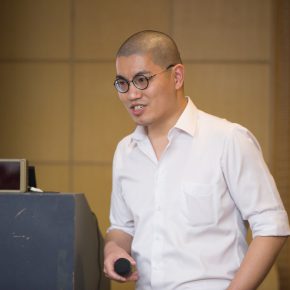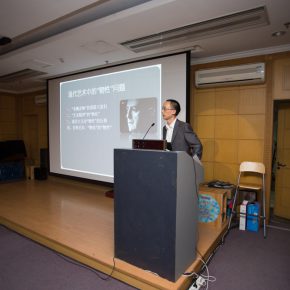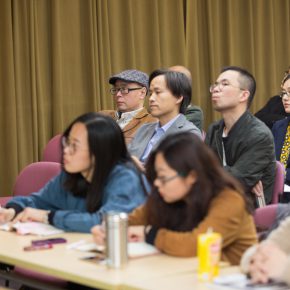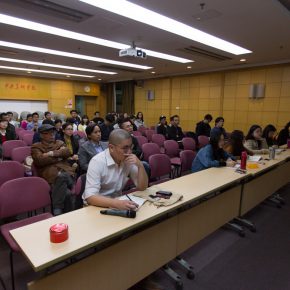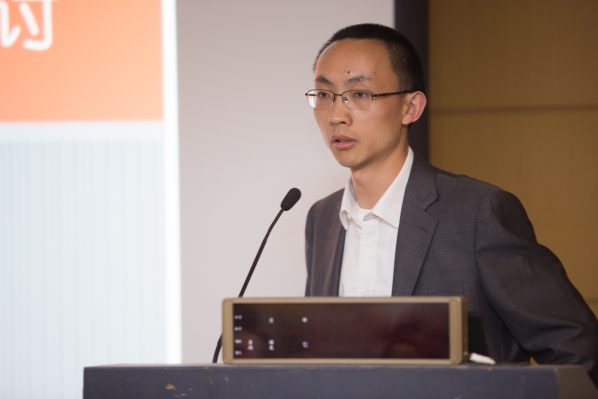
On the evening of April 15, 2016, CAFA “Walking into The Library” lecture 29 & The School of Humanities, CAFA “Literature and Art Forum” Session 47 was held in the lecture hall of CAFA Library. Post-doctoral student Chang Peijie from the Institute of Philosophy, Chinese Academy of Social Sciences gave a speech entitled “The Issue of ‘Material’ in Modern Art: a Discussion Focus on Adorno’s Aesthetic Theory”. The lecture was hosted by the young teacher Dr. Zheng Yi from the Department of Art History at the School of Humanities, CAFA.
Chang Peijie gave a speech that evidenced clear thinking, the lecture was divided into four parts, including: at first, the disappearance and return of “non-concepts”; secondly, the reification of “artistic spirit”; thirdly, the modernism that depresses the “material”; fourthly, avant-garde art: the reified material.
At the beginning of the lecture, Chang Peijie talked about the problem of how to define artworks, the previous artworks had certainty, but they had become lost in modern art. He took Duchamp’s “Fountain” as an example, it was a common urinal, but it became one of the masterpieces in the history of art. This problem started many discussions on aesthetics with art historians, including Adorno. Adorno’s “Aesthetic Theory” which responded to Heidegger’s article “Origin of the Works of Art”. Adorno was a German-born Jew, the special identity made him focus on the devastating incidents of violence in World War II, represented by Auschwitz Concentration Camp, and he thought that writing poetry was barbaric after Auschwitz, the lyricism was inappropriate. He criticized the cultural industry, and he was opposed to selling an artwork as a commodity. Adorno had a famous saying: “There is no right life in the wrong times”.
The Vanishment and Return of Non-Concepts
In the first part, Chang Peijie researched the thinking process of the problems of “truth” and “phenomenon” in western philosophy. The first one was Parmenides’s division of “the Way of Truth” and “the Way of Opinions”. Philosophy should think about a univocal invariable thing, only the fixed, invariable, eternal and solo existence was the truth. Then Chang talked about Socrates and Plato who respectively distinguished the experiential world and ideal world and Hegel’s absolute idea on the experiential world. Hegel had defined the essence of beauty: “Beauty is the sensible appearance of ideas”. In a word, in the western metaphysical tradition represented by the above philosophers, the common thing/ phenomenon was the suppressing of the “things”, they believed that the “truth” was imperceptible, invisible but thinkable, “phenomenon” was perceptible, visible but unthinkable, phenomenon could never serve as the object of philosophy, thus philosophers abandoned phenomenon, but persistently pursues the solo eternal invariable “existence”. Adorno fought against the identity of thinking and existence, fought against the previous philosophers who only sought for the fixed eternal simplicity, because it caused the sensorial repression, he pointed out that it was necessary to respect complexity, advocating the non-identity.
Reification of the “Artistic Spirit”
In the second part, Chang Peijie quoted Adorno’s definition of “artistic spirit” in the “Aesthetic Theory”: What appears in artworks is neither to be separated from their appearance nor to be held simply identical with it – the nonfactual in their facts – is their spirit.” Art conveys the truth by form. On the one hand, the concept of “reification” reflected the things that enslaved humans, for example, mobile phones controlled modern people’s lives, and on the other hand, it was the distortion of productive relations. Chang believed that the concept of “Verdinglichung/ Versachlichung”( Reification) that actually contained three meanings including “Objectification”, “Formalization” and “Things” in the Chinese context, which can be translated into the English term that contained the concept of “objectification” and “reification” which was similar to “entfremdung\ alienation”. Because of the reification, people have the risk of losing freedom and significance in modern society so artworks can be sold as commodities.
Oppression of the “Material” from the Modernism
In this part, Chang Peijie mainly talked about three problems, including the absolute nature of form, theatricality and art material. Chang said that: “Modern art distorted the original images of the objects, liberated form and artistic medium, so that art returned to the artistic medium itself.” For the absolute nature of form, the main ideas included Kandinsky’s artistic intrinsic inevitability, Greenburg’s absolute nature of form, Gasset’s artistic depersonalization and Shapiro’s development in what is useful and his abandonment of what is not in a “reproducing” artistic view. The art theme was dangerous, while the form was eternal, it was necessary for the understanding of all works of art to return to the level of form. For the problem of “theatricality”, he compared the practice of modernism and avant-garde. The characteristics of Modernism were the subjectivity and the subject-object dichotomy, and it was a kind of in-position mode for the public viewing of works of art; while the avant-garde art emphasized a sense of presence, to break the boundary of the subject-object dichotomy, so that the audience was involved in and participated in it, the work of art would be finished only when the audience participated into it. The third problem was the art material and Chang said modernism emphasized the legitimacy of art materials, the art material was important but invisible; but the avant-garde expanded the boundary of art material, which was visible but not important, such as various collages, so that the audience felt the existence of the material. Therefore, the practice of avant-garde art implemented the problem of “what was art” into the problem of “what was art material”.
Avant-Garde Art: Materiality of Reification
Chang Peijie mentioned the problem of the “artistic autonomy”. Before Adorno, the majority of people believed that art should not be interrupted by politics and morality, but art can engage in the problems later, which was a one-way view. While Adorno advocated a bidirectional artistic autonomy: art was neither interrupted by outside politics and morality, nor involvement in the real world. For the problem of “how to define art”, theorists tried to define art from the perspective of “relationships” but not “ontology”. Whether it was a work of art was not decided by itself but by the relationship between it and other works of art. Returning to the afore mentioned Duchamp’s “Fountain”, the small urinal was capable of becoming a work of art which was decided by the field it belonged to. The avant-garde art attempted to break the idea of modernism “Art for Art’s Sake”, and the avant-garde wanted the right of discourse, to strive for capitals in fields. Adorno’s view was: “The concept of art is located in an historically changing constellation of elements; it refuses to be defined.” i.e. located in the specific social and historical network, emphasizing the “truth content” of the art.
Text by Chen Yulian, Photo by Yang Yanyuan/CAFA ART INFO
Translated by Chen Peihua and edited by Sue/CAFA ART INFO



